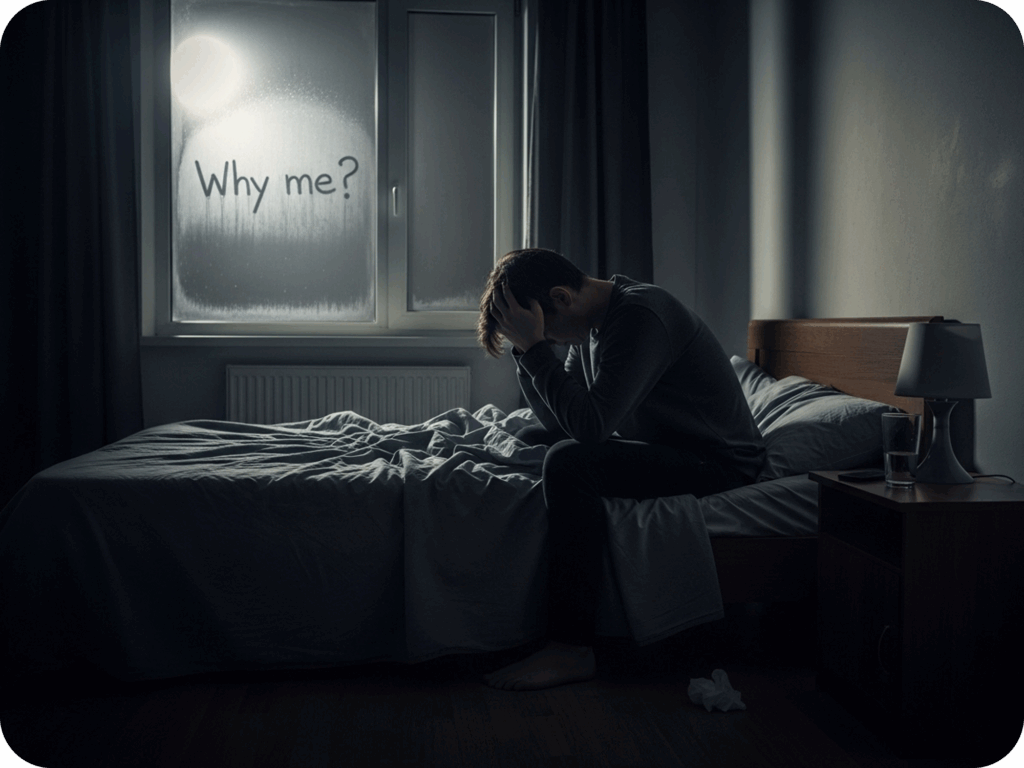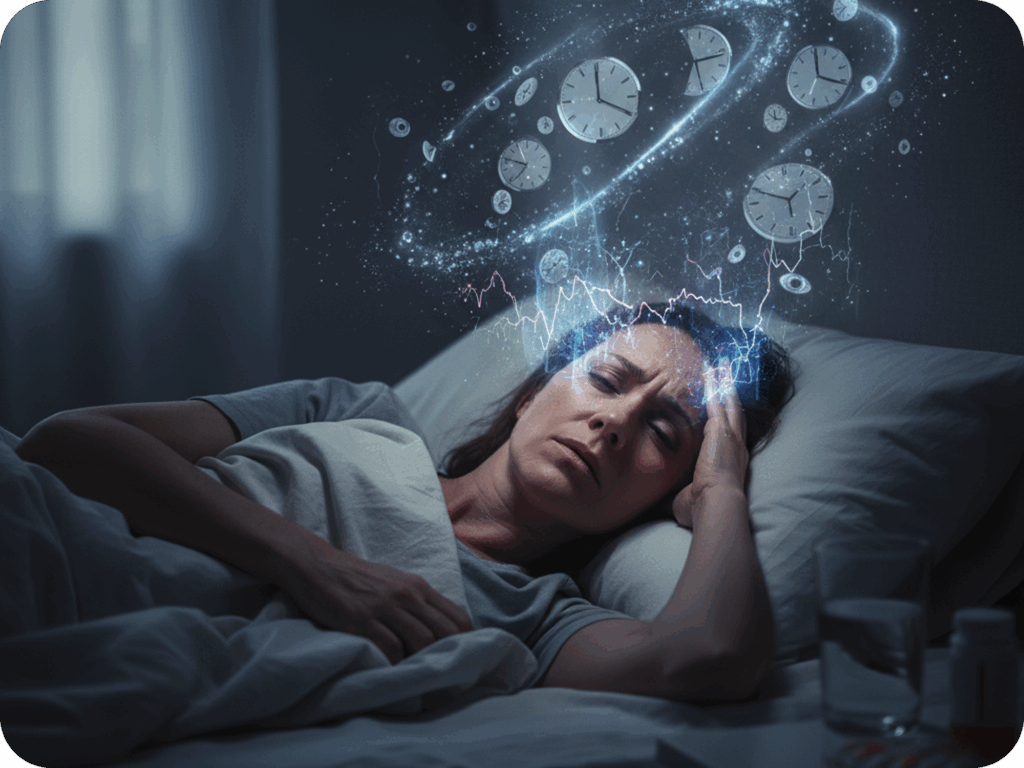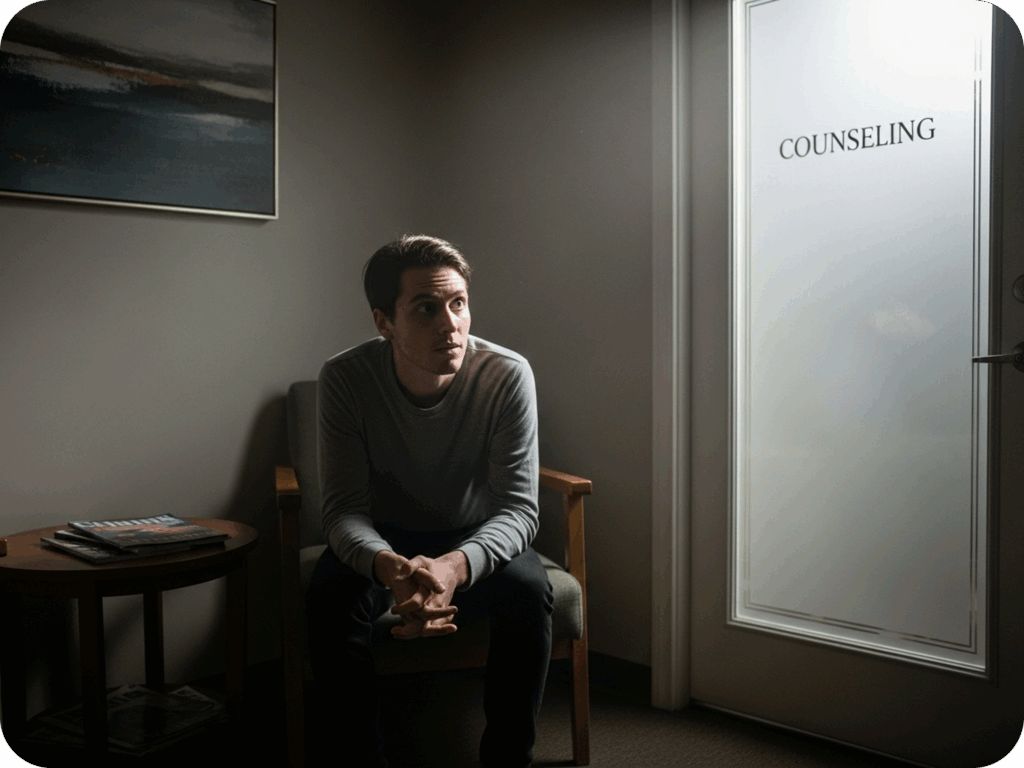How to Overcome Self-Pity and Embrace a Healthier Mindset
Key Takeaways
- Self-pity is an intricate emotional dance that is born of childhood experiences, social conditioning and personal disposition and that can ultimately take root as an automatic reaction to strain or misfortune.
- Extended wallowing is bad for your mental health, causing anxiety and depression and alienating friends, family, and colleagues, so it’s important to intervene early.
- Building self-awareness and catching yourself in moments of self-pity gives you the power to combat harmful thought cycles and replace them with more constructive coping mechanisms.
- Gratitude, self-compassion, and mindfulness all provide a way of redirecting attention from your own ‘woe is me’ behavior while building resilience, and remain valuable practices across cultures.
- Deep social bonds and meaningful activity offer critical networked support, diminishing loneliness and bolstering resilience against self-pity.
- Professional help should be sought if self-pity becomes overwhelming or persists. As mental health professionals provide great advice for tackling the root cause and achieving long-term healing.
Overcoming self-pity behavior is about recognizing when you lapse into self-blame or stuck-ness, and then discovering how to break that pattern. All of us encounter the occasional slump, but it’s what you do to get out of it that counts.
Simple daily steps such as contacting a friend or varying your schedule make a difference. In the following sections, concrete and simple strategies will demonstrate how to develop more resilient habits and attitudes.
The Psychology of Self-Pity
Self-pity is when a person becomes bogged down in the thinking about their afflictions, crushed by all that’s amiss in their life. It usually begins with a ‘Why me?’ mentality, in which an individual feels targeted by misfortune or injustice. This can ruin your mental well-being, strain your relationships, and impede your growth.

Extended bouts of self-pity can cause low self-esteem, diminished confidence, even chronic stress or depression. This self-pity cycle is typically accompanied by negative thinking rumination, dwelling on bad experiences, keeps people trapped in feelings of helplessness and isolation.
Its Origins
Childhood has a significant role in molding self-pity. If a child frequently receives comfort rather than direction when upset, they’ll learn to depend on self-pity to obtain assistance. Others are raised in households where it’s always somebody’s fault, but no one’s accountable.
They observe this and emulate it. Culture, too, molds this mentality. So many cultures incentivize victimhood, making it a means to garner notice or pity. Trauma and hardship can complicate this. When you experience repeated setbacks, particularly alone, self-pity can become a defense.
It can guard against further hurt but inhibits development. Certain personality types play a role. Sensitive, cautious or anxious personalities are more inclined to self-pity. They may prefer the solace of self-pity because it’s less threatening.

Its Triggers
Loss, rejection or failure are frequent provocateurs of self-pity. When people feel sad or frustrated, it’s a small step for these emotions to slip into self-pity, particularly if they think they’re powerless. Nothing like comparing yourself to others to compound the issue.
Whether it’s watching friends succeed or just the general feeling of falling behind, it can ignite sparks of ‘you’re not good enough. Constant stress, such as work pressure or a chronic illness, can erode a person’s resilience. Over the long term, these stressors make it difficult to recover from missteps and self-pity turns into a habit.
This practice holds the individual’s attention on the problem, and it becomes difficult to notice the opportunities.
Its Purpose
Self-pity provides. It comforts us by allowing us to escape hard reality or difficult decisions. For others, it’s a psychological addiction that provides temporary respite from suffering. Rather than using failures as an opportunity to learn, self-pity assists people in avoiding blame and dodging responsibility.
For it generates a camaraderie of pain. Sure, people can bond over suffering that can trap them in a spiral of self-pity. Pity can be an indication to demonstrate compassion and generosity, but self-pity isn’t so useful.
Self-compassion and empathy, whether from helping others, meditating, or thinking things through, writing, help break the feedback loop. It fosters a healthier relationship with feelings, so that adversity doesn’t seem terminal.
The Hidden Comfort of Self-Pity
Self-pity can appear like a velvety pillow in an uncomfortable world, a refuge where the sharpest edges of existence lose their sting. It carves a cocoon that holds back a portion of the ache and provides the appearance of order when disorder feels imminent. This comfort doesn’t last.

The temptation to retreat into self-pity can become powerful, hard to resist, a habit difficult to shake. Over time, what begins as a relief can come to call for increasing amounts of attention like a habit-forming drug. The dangers of taking this shortcut aren’t always obvious, but the tolls are tangible both for emotional well-being and for relationships.
A False Safety
Self-pity is not innate; it develops from conditioned behaviors, sculpted by history and conditioned by repeated encounters with disappointment. We fall into the self-pity habit without even thinking about it, particularly when stressed or let down.
Every time a person answers pain with self-pity, it’s easier to answer it that way again. This cycle can ensnare people, self-feeding and blinding them to an escape. To break this cycle, it aids to observe what activates self-pity and when it emerges.
Journaling is an option. By jotting down thoughts and feelings as they occur, it’s easier to identify patterns and triggers. For instance, one might notice that self-pity comes on after criticism at work or an argument with a friend. As these realizations accumulate, they pave the way to experiment with new coping methods, such as cognitive reappraisal or calling a trusted confidant.
An Emotional Habit
Self-pity is a consolation in the form of an easy scapegoat. When life is unjust, it’s easy to shoot the messenger to focus on what other people do wrong, instead of yourself. This habit can be a growth blocker, as it transfers accountability from the self to external factors beyond your control.
The more you blame others, the more difficult it is to shift. Taking ownership of feeling is part of the magic. It means posing questions such as, ‘How did I contribute to this?’ or ‘What can I do next time?’
This type of rumination deepens your capacity to troubleshoot. Development relies on it. Without it, problems stay unsolved and blows feel terminal.
A Blame Deflector
Of course, wallowing in self-pity can be burdensome for your psyche. It typically results in additional stress, anxiety and even depression. Then the misery swells, and a sense of futility can set in.
This makes it difficult to relate to others, fraying friendships and family bonds. It can hinder forward momentum at work, as productivity wanes and minor grievances grow.
Self-pity occasionally masks underlying issues, such as an approval hangover or inferiority complexes. To confront these matters requires bravery and integrity.
It requires a strong will to change, as well as help from friends, mentors or therapists. Confronting painful reality is difficult, but it is the only path to progress.
How Self-Pity Harms You
Self-pity is not merely a momentary emotion; it represents a victim mentality that can inform your thoughts, behavior, and interaction with the world. When self-pity turns habitual, it wreaks havoc on your emotional state, leading to persistent feelings of hopelessness and negativity. Knowing these warning signs is crucial in disrupting the cycle and creating a healthier path forward.
Mental Health
Self-pity, after all, manifests in the body as well as the mind. When you indulge in negative emotions, you could feel fatigued for no reason or even become ill more frequently. That’s because the stress of self-pity can suppress your immune system, increase your risk for chronic disease, and exhaust your energy. Moreover, this victim mentality can lead to persistent feelings of hopelessness and misery.
When you’re caught in self-pity, it becomes a downward spiral, making you feel stuck. This damages your self-esteem and makes it more difficult to get through your day. Studies demonstrate that emotions such as self-pity can cause actual health issues, hindering your ability to cultivate a positive mindset.
Incessant stress and sadness can alter your physiology, making you more susceptible to headaches, stomach problems, or sleep issues. Others discover that they get stuck in a negative feedback loop, feeling bad, then feeling worse due to the physical wear and tear. To break this cycle, practicing gratitude can significantly improve your emotional state.
Taking care of your emotional well-being is equally important as taking care of your body. If you brush these feelings aside, they can accumulate and exacerbate. Engaging in physical activity, even a brief walk, can improve your mood and help you develop inner resilience against negative experiences.
Physical Well-being
Self-pity will bottle you up, make it difficult to come out of yourself and see others, connect, communicate and trust. When you focus solely on your own pain, you begin to withdraw from friends and family, believing that nobody else can possibly relate.
It can make you feel isolated or even suspicious of those who care. Isolation frequently ensues. You may feel like you’re the only one or that nobody wants to hear. This can make you less apt to talk about your feelings, which makes it even more difficult to receive the support you deserve.

Open, candid discussions with trusted individuals can assist you in viewing your issues with a fresh perspective and remind you that you are not isolated.
Personal Relationships
When self-pity gets ahold of you, it can stall you at work or school. Self-pity interferes with self-motivation and makes it hard to initiate or complete assignments. Long term, this damages your work and prevents you from progressing.
It makes it easy to overlook opportunities for growth. In concentrating on what’s gone wrong, you might overlook the talents or abilities you possess. To develop resilience springing back from difficulty is to establish achievable, tangible goals and accept setbacks as part of the human experience, not a special punishment for you.
Professional Growth
To escape self-pity, begin by observing when these emotions arise. Self-awareness is a powerful weapon. When you find yourself slipping into old thought grooves, halt and inquire about alternatives.
To be active, not passive, with your feelings is to keep self-pity at bay. Owning your decisions and behaviors is critical. You can’t always change what happens, but you can choose how you respond.
Self-compassion, treating yourself with kindness, remaining mindful, and viewing your suffering as a universal human experience, propels you into action.
A Practical Guide to Overcoming Self-Pity
Self-pity is a natural reaction, but if you don’t manage it, it’ll sap your energy and cultivate a damaging mindset. To break the cycle of self-pity, practice gratitude and develop inner resilience; this guide, inspired by Try’s technical insights and personal strategies, is applicable to professionals and students around the world.
1. Acknowledge the Feeling
Accept that self-pity is human. There’s nothing wrong with letting yourself be sad, or disappointed sometimes that’s the first step to moving on. It is important not to marinate. Instead, affirm what you feel, then open up room for transformation.
Question self-pity’s negative thoughts. Frequently, such ruminations originate from toxic core beliefs or cognitive distortions for instance, that things are always bad or that setbacks are permanent. When such patterns emerge, question whether they’re really true. This little bit of critical thought can begin to erode their hold.
Write or talk through what you feel. Whether journaling or venting to a trusted friend, articulating the emotion will make it less suffocating and allow you to view the circumstance with more clarity.
How about jotting down some positive mantras as an antidote to the negative self-talk? This exercise may help reframe your thinking.
2. Challenge the Narrative
Self-pity feeds on unbridled narratives. To unsettle the loop, aggressively search for different perspectives.
Put a different spin on it! For instance, rather than, “I always fail,” say, “What have I learned here?” Jotting down an accomplishment or positive characteristic can additionally redirect.
Affirmations can help reinforce new narratives. Thinking is key be skeptical of such generalizations and seek out their disconfirming evidence.
3. Practice Active Gratitude
There is nothing like gratitude as an antidote to self-pity. Small steps, such as writing down three things you are grateful for, can ease the attention away from your issues and toward the blessings.
Maintain a gratitude journal. This practice, eventually, trains the mind to seek out the good moments, even on tough days. Experiment with mini gratitude workouts every morning or night.
Gratitude increases your mental health, according to research. It reduces stress, increases mood, and aids in escaping the self-pity hamster wheel.
4. Embrace Self-Compassion
When things get difficult, be there for yourself as you would a good friend. Self-compassion is about being kind, not critical, to your errors.
Mindfulness meditation can be helpful. By observing thoughts non-judgmentally, you can relieve self-criticism. As it’s practiced over time, self-compassion builds resilience and helps you rebound from setbacks.
5. Take Small Actions
Small steps count. Even small actions cleaning your room, making a call, volunteering upend self-pity and initiate an upward spiral.
Do something fun or something for someone else. These activities redirect attention from your personal suffering and provide meaning.
Use those small wins, no matter how minor, to help build momentum.
6. Build Emotional Resilience
Emotional resilience is crucial for managing adversity. Build coping muscles—such as breathing, exercise, or routines to handle stress.
Positive relationships are crucial. Friends, mentors or support groups can raise you above the spiral.
Continued self-work therapy, self-reflection, etc builds up those habits of the mind, so that self-pity is less likely to stick in the future.
Building Emotional Resilience
Emotional resilience is not a gift but a practice that encourages us to cultivate a positive mindset. By learning to accept and process uncomfortable emotions instead of succumbing to self-pity, we can minimize feelings of despair and react constructively to setbacks. Mindfulness, community support, and purpose are essential steps for building inner resilience.

Mindfulness
Mindfulness builds emotional awareness by training the mind to observe feelings and thoughts as they surface, without judgment or resistance. Meditation, particularly loving-kindness meditation, opens a space for you to witness your emotions and ease self-judgment, allowing for a more positive mindset. This practice fosters kind inner dialogue and shatters self-pity cycles, promoting inner resilience.
Consistent mindfulness, such as deep breathing or journaling, allows people to work through and purge negative feelings. Journaling brings clarity to the patterns and creates distance from distress. These humble daily practices of mindfulness—like noticing the feel of water in your shower or taking a breath between meetings—can be effortlessly integrated into habits and make a profound difference in your emotional state.
Being present in the moment prevents you from ruminating on old hurts and helps you cultivate a fulfilling life. Mindful awareness roots us, enabling us to meet setbacks with equanimity and extract lessons from them. Over time, these habits cultivate emotional resilience, viewing challenges as opportunities for growth rather than reasons for despair.
Community
Support from others is crucial when struggling to overcome self-pity. Building connections with people who understand or have similar experiences can break down isolation and build resilience. Participating in communal experiences whether it’s group volunteer work or attending local cultural events provides a feeling of connection and collective meaning.
Such relationships flourish in compassion and kindness. When students feel heard and accepted, they’re less prone to wallowing in self-pity. Community support fosters self-compassion by reminding us that we’re all facing struggles acknowledging this common humanity normalizes setbacks and increases resilience.
Purpose
Seeking significance outside suffering moves us away from victimhood and toward empowerment. Pursuing something whether it’s achievable goals or interests—like learning a skill or joining a cause can give your days purpose and drive. Even a little purpose is enough to harden one’s heart and build resilience.
Individuals tend to experience increased meaning when they are working toward something beyond themselves. Maybe it’s mentoring, or assisting a neighbor, or engaging in a community project. These actions cultivate compassion and remind us that personal adversity is less a personal failing than a universal condition.
Professional Support
Self-pity can sometimes be overwhelming or persistent. Knowing when to get professional help is important. Therapy provides room to tackle root causes, change self-critical rumination, and cultivate healthier coping strategies. Psychotherapists can assist you in cultivating self-compassion and shifting your perspective to see difficulties as opportunities for development.

When setbacks feel too heavy to shoulder on your own, asking for help isn’t weakness it’s resilience. Ongoing issues are best addressed early, ideally with the support of trained professionals, who can give you a better chance of achieving enduring change and emotional resilience.
When to Seek Professional Help
Self-pity, for example, can be a healthy response to disappointment, but when it’s a daily occurrence or begins to define our perceptions of ourselves and others, it could indicate an underlying problem. Understanding when to seek professional assistance is crucial for individuals looking to overcome limiting patterns and begin developing healthier coping mechanisms.
Chronic stress, anxiety, or depression that makes it difficult to get through the day is typically a cue to seek additional support. When sadness or worry persist for weeks or months, interfering with sleep, appetite or motivation to reach out to others, these are all good cues that help is needed.
For instance, a young techie who struggles to concentrate post-hard project and pulls away from friends could benefit from consulting a mental health expert. This assistance can aid in sorting through the underlying causes and developing healthier ways to manage distress.
Low self-esteem is yet another area where getting some help can do a world of good. When people lug around accumulated rage or frustration or feel like they’re not good enough, those convictions can infect every aspect of life from work to relationships.
Professional help can provide them with the means to transform their self-perception, develop new mechanisms to cope with adversity, and recover from past trauma. For example, a young analyst who can’t accept that they’re good enough, even after you compliment them, may benefit from therapy that can help challenge their negative beliefs and establish more realistic aspirations.
Relationship issues, loneliness or a sense of isolation are motive to search for external assistance. If someone feels isolated from others or struggles to develop close relationships, a counselor can assist with developing social skills and addressing feelings of rejection or mistrust.
This is crucial for people who travel frequently for work or study overseas where support systems are slim. When the negative thoughts and feelings become too much to carry, or self-pity is a daily ritual, professional help can provide a safe space to process and learn new coping skills.
If you feel stuck, even after self-help books or advice, a mental health professional can provide new perspectives on problems and actions to break old patterns. Significant life events such as the loss of a loved one, battling a chronic illness, or relocating to another country are all moments when feelings can be difficult to manage.
Help around these shifts can make the adjustment much easier and stop the self-pity from sinking in.
Conclusion
To get beyond self-pity, begin with what fits real life: small steps. Be aware of your triggers and label your emotions. Invoke simple habits such as daily walks or quick chats with a friend. These things accumulate actual power. Self-pity feels secure, but it traps you. Growth requires you to confront pain, believe in your abilities, and do stuff that makes you nervous. You don’t have to do this alone help from a pro can make a huge difference. Your story counts, and there’s always room for adjustment. Stay curious, stay connected, stay generous. Jump in the discussion below your insight may assist another reader as well.
Frequently Asked Questions
What is self-pity?
Self-pity, often characterized by a victim mentality, leads to a focus on unfairness rather than practicing gratitude and finding solutions to life’s inevitable hardships.
How does self-pity harm mental health?
Self-pity magnifies feelings of powerlessness and alienation, leading to a victim mentality that can foster anxiety or depression, ultimately hindering your ability to practice gratitude and build inner resilience.
Why do people find comfort in self-pity?
Self-pity may provide temporary relief and validation to your feelings, but it often leads to a victim mentality that hinders your progress towards a fulfilling life.
What are practical steps to overcome self-pity?
Acknowledge your thoughts and practice gratitude; taking action through small goals and support can help you break free from the cycle of self-pity.
How can building emotional resilience help?
Emotional resilience enables you to navigate life’s inevitable hardships and bounce back faster, liberating you from self-pity and fostering a positive mindset.
When should I seek professional help for self-pity?
If self-pity is stubborn and impacting your daily life, relationships, or emotional state, consider seeking a mental health professional for encouragement and support in overcoming these negative feelings.
Can self-pity ever be helpful?
A short bout of self-pity can signal that you’re missing something or hurting, but staying in this victim mentality for extended periods is unproductive; instead, practice gratitude to cultivate inner resilience.
Key Takeaways
- Suddenly stopping heavy drinking can dangerously spike brain activity and cause seizures which is why safe detox and tapering methods are so crucial.
- Long-term alcohol use alters neurotransmitter levels, especially GABA and glutamate, potentially making seizures more likely even beyond acute withdrawal.
- Both withdrawal hyperexcitability and electrolyte imbalances, which frequently occur due to dehydration or malnutrition, dramatically increase the risk for alcohol-induced seizures and thus necessitate close medical supervision during cessation.
- Those with underlying neurological disorders, a genetic seizure predisposition, or who combine alcohol with other drugs are at increased risk and should discuss mitigation strategies with their health care providers.
- Being aware of the seizure’s early indicators, such as disorientation or abnormal motions, and informing close ones to prepare them, can help facilitate prompt treatment and mitigate the likelihood of serious consequences.
- Forward-looking prevention, through support groups, ongoing medical oversight, and enduring life changes, is essential in reducing seizure risk for individuals affected by alcohol-borne seizure risk.
Alcohol-induced seizure risk refers to the likelihood of experiencing a seizure following alcohol consumption. Even small amounts can trigger seizures for some, but risk increases with heavy or long term drinking.
Those with epilepsy may be at elevated risk, but anyone can get caught up. Being aware of the symptoms and risks can assist individuals in making informed decisions when it comes to drinking alcohol.
The following sections segment symptoms, causes, and methods to reduce that risk.
How Alcohol Triggers Seizures
Alcohol triggers seizures in a combination of ways through general shifts in the brain, body chemistry and withdrawal. Both heavy drinking and sudden cessation following long-term use can increase the risk.
Here’s a table of essential factors associated with alcohol-induced seizures.
Factor | Description |
|---|---|
Brain Chemistry | Alters neurotransmitter balance, especially GABA and glutamate |
Withdrawal Hyperexcitability | Increased brain sensitivity after stopping alcohol, triggering seizures |
Electrolyte Imbalance | Disrupts sodium, potassium, calcium; worsens seizure risk |
Structural Brain Damage | Chronic misuse leads to long-term brain changes, lowering seizure threshold |
Lowered Seizure Threshold | Makes it easier for the brain to have seizures |
1. Brain Chemistry
Alcohol alters the communication between the brain’s neurons. It mostly affects two chemicals: GABA, which calms brain activity, and glutamate, which excites it.
Alcohol potentiates GABA and inhibits glutamate. That’s why folks get mellow or drowsy when they imbibe.
Over time, drinking compels the brain to compensate by down-regulating GABAA receptors and up-regulating NMDA glutamate receptors. When a person quits drinking abruptly, these shifts can cause the brain to become hyperactive.
This hyperactivity can trigger seizures, particularly in individuals with a history of chronic alcohol use. This continued vulnerability to seizure stems in part from the fact that chronic alcohol use causes long-term shifts in nerve cell firing, making the brain more likely to seize even after withdrawal.
2. Withdrawal Hyperexcitability
When a heavy drinker quits, the brain shifts into withdrawal hyperexcitability. This entails nerve cells becoming hypersensitive and overfiring.
These withdrawal seizures typically occur within 6 to 48 hours of the last drink. They may be tonic–clonic or, more rarely, partial seizures.
Symptoms such as tremors, diaphoresis, and nervousness are typical of pre-seizure activity. If unmonitored, this condition can deteriorate rapidly so treating withdrawal with professional care is essential to reduce seizure danger.
3. Electrolyte Imbalance
Heavy drinking usually causes low sodium, magnesium, and calcium. These imbalances leave seizures more prone to occur.
Dehydration from alcohol and low blood sugar contribute. During detox, monitoring and correcting electrolytes supports brain stability.
Eating and drinking well post-alcohol cessation promotes nerve health and reduces seizures.
4. Structural Brain Damage
Decades of drinking can shrink and scar the brain. This damage leaves the brain more prone to seizing.
Wernicke-Korsakoff syndrome, a brain disease from long-term alcohol misuse, can drop the seizure threshold.
Brain injuries from falls or other alcohol-associated accidents contribute as well. These long-term effects frequently linger after ceasing alcohol.
5. Lowered Seizure Threshold
The seizure threshold is the brain’s susceptibility to seizures. Alcohol lowers this threshold, particularly with chronic use or in individuals who have experienced seizures previously.
Over time, each bender deposits more, making seizures increasingly probable. If you have a history of seizures, you have to be extra careful with alcohol.
Monitoring consumption and steering clear of binging maintains a higher threshold.

Intoxication Versus Withdrawal Seizures
Alcohol can trigger seizures in two main ways: through intoxication or through withdrawal. Understanding the distinction is essential for optimal treatment and rapid reaction. Both types endanger the brain yet act through different mechanisms and timelines.
Seizures are a key aspect of alcohol use disorders as evidenced by many studies, and understanding their timing and characteristics can inform treatment. The table below shows the main differences between intoxication and withdrawal seizures:
Seizure Type | Timing After Last Drink | Common Triggers | Features | Implications for Care |
|---|---|---|---|---|
Intoxication Seizure | During or soon after use | Alcohol poisoning, head trauma | Less common, often focal | Assess for injury or overdose |
Withdrawal Seizure | 6–48 hours post-cessation | Abrupt stop after chronic use | Usually generalized tonic–clonic | Prevent further withdrawal |
Withdrawal seizures most commonly hit between 6 and 48 hours after alcohol use ceases. These are typically generalized tonic–clonic but can be partial as well. These seizures tend to come on after heavy, extended use and abrupt cessation.
Other indicators, such as blackouts, tremors, rigidity, and delirium tremens, can manifest during withdrawal. Delirium tremens a violent form of withdrawal can begin three to eight days after the last sip and is life threatening. Withdrawal seizures indicate profound alterations to the brain’s equilibrium.
Alcohol, a CNS depressant, increases GABA the chief brake in the brain so that when it is discontinued, the body downregulates GABAA receptors and upregulates NMDA receptors. This leaves the brain hyperactive and seizure prone. Individuals with prior withdrawal seizures or history of epilepsy are at increased risk.
By contrast, intoxication seizures occur during the presence of alcohol in the system, typically in the context of poisoning or post-trauma while inebriated. These are less frequent than withdrawal seizures and often indicate acute brain insult, not simply chemical shifts.
In medicine, what causes the seizure is important. If someone comes into the hospital following a seizure, physicians must know whether this occurred during intoxication or following withdrawal. Tests such as carbohydrate deficient transferrin and other markers may assist in confirming alcohol use.
That directs subsequent management–be it stabilizing the patient, halting withdrawal, or addressing trauma. Treatment and management vary by etiology. Withdrawal seizures require medical monitoring and often medications to prevent further seizures and control symptoms.
Intoxication seizures can require acute care for poisoning or trauma. In both cases, long-term plans emphasize minimizing your alcohol use and relapse prevention which is essential for individuals with a history of seizures.
Identifying Your Personal Risk
Identifying your personal risk for alcohol-induced seizures begins with examining your lifestyle, health, and genetics, especially in the context of alcohol dependence and heavy alcohol use. This section dissects the primary risk factors, illustrating how each can sculpt your individual risk profile.
Consumption Patterns
- Track how many days per week you drink alcohol.
- Record your typical ‘serving’ (average # of drinks per session – use ml for accuracy, e.g. 150 ml wine, 330ml beer).
- Note whether you’re a heavy episodic drinker (i.e. consume > 60g of pure alcohol in one sitting).
- Identify any patterns of escalating drinking over time.
- Watch for signs of AUD like not managing daily tasks because of drinking, or requiring more alcohol to get a buzz.
- Know that roughly half of those who abruptly quit or reduced heavy drinking get alcohol withdrawal syndrome the biggest risk for seizures.
- Plan to alter drinking by establishing hard limits or designated alcohol-free days to minimize risk.
Preexisting Conditions
- Watch if you suffer from a neurological disorder, like epilepsy, this increases seizure risk when drinking. Note any new or increasing symptoms while continuing to drink.
- Chronic conditions, such as epilepsy, have a notorious adverse interaction with alcohol. Even low-level drinking can alter seizure thresholds, increasing the risk of episodes and resistance to treatment.
- If you experience new symptoms confusion, tremors, atypical movements after drinking, see a healthcare professional immediately, particularly if you have a neurological history.
- Once again, if you suffer from any chronic medical condition, always discuss safe drinking levels with your medical team. They might recommend total avoidance or rigid boundaries.
Genetic Predisposition
Genetics may play a role in how your nervous system reacts to alcohol, such as your seizure risk. If you have a first-degree relative with seizures, your threshold for alcohol-related seizures may be below average. A few studies back genetic counseling if you have a family history of epilepsy or related disorders particularly if you’ve presented with any symptoms yourself.
Your personal genetic profile along with certain drinking behaviors can increase this risk, so paying attention to alterations after drinking is crucial.
Concurrent Substance Use
Combining alcohol with other substances such as sedatives, stimulants or recreational drugs—can trigger seizures. Other medicines, like certain antidepressants or antipsychotics, interact poorly with alcohol, increasing dangers.
Even over-the-counter medications could have cautions against mixing with alcohol. Side effect monitoring is essential if you use multiple substances. Avoiding such combinations, especially in individuals with a history of withdrawal symptoms or existing medical conditions, is a simple measure to reduce risk.

Recognizing the Warning Signs
Recognizing the warning signs of alcohol-related seizure risk is about knowing what to look for and moving quickly. Anyone who quits or reduces drinking, particularly those with unhealthy alcohol use or alcohol use disorder, can begin experiencing alcohol withdrawal. Approximately half of them will display withdrawal and as high as a third will have seizures.
These seizures typically begin 6–48 hours after the last drink and are most commonly generalized tonic–clonic in nature. Other folks may experience partial seizures. Because it’s so common particularly among frequent drinkers recognizing the warning signs is crucial for seeking prompt assistance.
The early signs can manifest in body and mind. Confusion is among the earliest things to heed for. Someone might appear lost, or forget easy things, or behave oddly. Agitation is frequent as well. This may appear as restlessness, difficulty sitting still, or irritability.
Sometimes, odd movements shaking, twitching, or even muscle jerks that are difficult to control. These motions can begin gentle, but they can become severe rapidly. Sweating, a pounding heart, and insomnia are typical of early withdrawal. When these signs present themselves, don’t wait.
The danger of seizures is greatest during the initial 48 hours following alcohol cessation, therefore, this is the critical period when individuals require the most vigilant observation. If they begin to exhibit these symptoms, seek immediate medical attention.
Seizures can occur with minimal warning and result in severe complications such as alcohol withdrawal delirium. This extreme withdrawal can be fatal, but it occurs in a minority of cases. Yet the danger is serious enough that anyone exhibiting warning signs should be screened, particularly if they have a prior history of bad withdrawals.
There are instruments that physicians employ to identify patients more prone to withdrawal delirium, and these tools can direct treatment. It just makes a world of difference. Friends, family, roommates all of them should know what the warning signs look like so they can act quickly if necessary.
If they notice consternation or restlessness or strange gyrations in an abstainer, they dare not hesitate. Dialing emergency assistance may just save a life. Nearly two million Americans experience alcohol withdrawal annually, which is why everyone not just longtime drinkers needs to know these signs.
The Neurological Echo of Alcohol Abuse
Alcohol abuse affects the nervous system in distinct ways, and these effects can persist long after one ceases alcohol intake. These brain alterations can elevate the risk for alcohol withdrawal seizures, particularly during withdrawal or in individuals who consume alcohol for prolonged durations. This danger isn’t isolated to any group or region. It’s a genuine affliction for millions of alcoholics and ex-alcoholics everywhere.
Alcohol-induced neurological deficits may manifest as increased seizure activity, both short- and long-term. Even after you quit, the chance for new seizures can remain elevated—especially if the brain is still recovering. Individuals with a history of excessive alcohol use may require extended or continuous monitoring for seizure frequency. The risk of recurrent seizures increases with heavy alcohol use.
Chronic alcohol consumption can alter brain function. It occurs because alcohol damages critical brain cells, causing them to be less able to suppress excitation. For instance, low concentrations of ethanol can enhance the tonic inhibition in the hippocampus by activating extrasynaptic GABAA receptors. This can throw off the brain’s normal balance over time.
It’s this overactivity the neurological echo of alcohol abuse that’s the culprit when seizures begin after someone stops drinking. Research indicates that alcohol withdrawal seizures typically start 6 to 48 hours after a person’s last drink. These are typically generalized tonic–clonic seizures, although they can occasionally be partial. This is no minor threat; approximately 2 million Americans experience withdrawal symptoms annually.
Data suggest that firing in areas such as the inferior colliculus increases during withdrawal, predisposing people to having sound-induced seizures. Following the long-term fates of those with alcohol-related seizures provides greater clarity. In one study, nearly 10% of people had their diagnosis revised during follow-up, highlighting the complexities of alcohol use disorder.
The more you drank, the more seizures you were destined to have down the road. Seizures occurring within a day of the first event were not considered recurrences—only those with intervening time counted. Among a cohort of patients followed for these problems, more than half had recurrent alcohol-related seizures, and roughly 40% developed a diagnosis of medicine-requiring epilepsy.
Models for seizure recurrence and epilepsy in these individuals performed well, with AUC scores above 0.8 and 0.9, indicating that continuing risk can be predicted with impressive accuracy. Understanding these patterns is crucial for effective alcohol detoxification and managing potential seizure disorders.

Proactive Prevention and Management
Alcohol withdrawal seizures are serious health consequences that can occur due to withdrawal or chronic alcohol use. A proactive approach requires you not just to care about immediate safety, but also long-term well-being. Managing that risk involves combining medical, psychological, and lifestyle strategies, while creating a support system for those impacted by alcohol dependence.
Safe Detoxification
Safe detox should always be paramount for those in withdrawal and seizure risk. It can be dangerous to suddenly quit drinking, particularly if you’ve been a long-term heavy drinker. Medically supervised detox programs minimize the chances of seizures and intense withdrawal symptoms.
Health teams may turn to medications like benzodiazepines to suppress the acute symptoms and bring the nervous system back to a foundational sense of stability. Others will require a slow, gradual tapering schedule to reduce alcohol consumption in a medically safe manner. This incremental method conditions the brain and decreases the chances for breakthrough seizures.
For patients with past extreme withdrawal issues, such as seizures or delirium tremens, inpatient programs offer 24/7 supervision and immediate treatment should symptoms occur. Sufficient hydration with non-caffeinated beverages and a daily multivitamin with folic acid and thiamine keeps the body nourished through this method and prevents the deficiencies typical in alcohol detox.
Medications such as gabapentin or topiramate can be utilized as second line agents for AUD, providing extra seizure protection and diminishing cravings.
Medical Intervention
Acute withdrawal seizures are in need of urgent care. Early treatment in these cases can stop complications such as prolonged seizures or trauma to occur. Antiepileptic drugs can be used to control seizure activity, particularly if the person has a history of epilepsy.
Routine check-ins with healthcare professionals is key. These visits provide continuous oversight of alcohol consumption, medication side effects, and treatment plan modification. Working together makes certain treatment stays personalized to the patient’s medical record and needs.
Patients and providers jointly evaluate the risks and benefits of therapy. Side effects or drug interaction monitoring is key, especially if there are multiple medications. Adjust as necessary, of course with patient safety as a primary concern.
Lifestyle Adjustments
Lifestyle modifications can be great anti-seizure weapons. Balanced nutrition, daily exercise, and adequate sleep all promote brain health and decrease the risk of complications. Pushing away known triggers like binge drinking or high-stress scenarios can count.
Developing a sober support network, be it through community groups, online forums, or personal connections, reinforces positive habits and minimizes isolation. Proactive prevention and management – Stress management techniques, such as mindfulness, therapy, or relaxation exercises, can reduce relapse risk and stave off substance misuse.
For individuals at elevated risk, particularly individuals with a prior history of seizure or epilepsy, additional measures are warranted. Restricting or abstaining from alcohol, engaging in support groups, and continuous medical monitoring are aspects of holistic care.
- Participation in support groups or rehabilitation programs:
- Provides peer accountability and emotional support.
- Offers education about addiction and recovery.
- Reduces stigma and builds community connections.
- Encourages skill development for long-term sobriety.

Conclusion
Alcohol can interfere with the brain’s wiring in ways that cause real problems. Too much booze or quitting cold turkey after heavy use can open the door to seizures. What’s the science behind it? It turns out that alcohol disrupts signaling activity in the brain, causing neurons to randomly misfire. Individuals with a seizure history or certain health conditions are at greater risk. Easy markers such as shakes, disorientation, or blackouts are important and can’t get waved away. Keeping up with these facts keeps you safe. If you or someone close suffers from these issues, seek assistance or consult a physician. Spread the knowledge, take care of one another, and stay brain aware.
Frequently Asked Questions
What is the link between alcohol and seizures?
Alcohol can be disruptive to brain activity, and excessive alcohol intake or abrupt discontinuation can induce alcohol withdrawal seizures, particularly among individuals with underlying medical issues.
Are seizures more likely during alcohol withdrawal?
Yup — alcohol withdrawal seizures typically take place 6 to 48 hours after ceasing heavy alcohol use or regular drinking.
Can someone have a seizure while intoxicated?
Infrequently, alcohol withdrawal seizures can occur during deep intoxication, particularly with dangerously elevated blood alcohol levels or in individuals with epilepsy.
Who is most at risk for alcohol-induced seizures?
Individuals with a history of epilepsy, significant alcohol use, or alcohol withdrawal seizures are placed in this category, as genetics and general health are also contributing factors.
What are warning signs of an alcohol-induced seizure?
Red flags would be anything like feeling confused, having a sudden loss of consciousness, or experiencing twitching or jerking movements, which could indicate potential alcohol withdrawal seizures. Get medical assistance right away if these happen.
How can I prevent alcohol-induced seizures?
Keep alcohol consumption to a minimum to avoid alcohol withdrawal seizures, steer clear of binge drinking, and never abruptly cease heavy drinking without medical assistance.
What should I do if someone has an alcohol-induced seizure?
Protect the individual experiencing alcohol withdrawal seizures and, if possible, position them on their side. Don’t stick anything in their mouth. Request emergency medical assistance immediately.understanding-alcohol-induced-seizure-risk-and-its-connection



